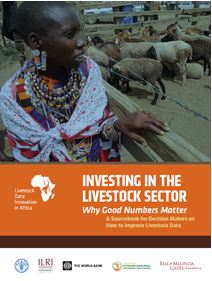



Why Good Numbers Matter for the Livestock Sector and How Decision Makers Can Improve Them
Better data is needed in order for sustainable livestock growth strategies to be implemented appropriately, a new World Food and Agriculture Organisation (FAO)report has found.Ugo PicaCiammara and Nancy Morgan, an agricultural economist at the FAO, write that growing demand for animal produce in developing countries requires more maths and science in food production.
The growing demand for food of animal origin in developing countries represents a major opportunity for poverty reduction, writes Nancy Morgan.
Livestock ownership is recognized as a significant contribution, and in multiple ways, to households’ livelihoods, including through the provision of cash income, food, manure, hauling services, savings, insurance and even social status.
This is the area covered in the FAO's latest report, Investing In the Livestock Sector: Why Good Numbers Matter.

In order to sustain and promote the livestock sector’s development, good quality data are needed for designing and implementing policies and investments. However, available livestock data, and the derived statistics, are largely considered inadequate for effective decision-making.
While a review of existing agriculture- and livestock-related datasets for African countries suggests that some livestock-related indicators do exist at the country level, they are few in number, are rarely collected on a regular basis, and their quality is often questioned by livestock stakeholders with regards to their timeliness, completeness, comparability and accuracy.
There is often limited institutional collaboration between data collection agencies and furthermore, statistical systems rarely, if ever, generate data on pastoral production systems, which are of considerable relevance to many African countries.
In an effort to address the myriad of challenges associated with generating livestock data useful for decision makers, the Livestock in Africa: Improving Data for Better Policies Project was developed.
The Project was implemented between 2010 and 2013 by the World Bank, the UN Food and Agriculture Organization (FAO), the International Livestock Research Institute (ILRI), and the African Union, in collaboration with the pilot countries of Uganda, Tanzania and Niger, and with financial support from the Bill and Melinda Gates Foundation. One of the main goals of this collaborative initiative has been building the capacity of national governments to collect better quality livestock data and using this to guide investment decisions for the livestock sector.
At the conclusion of the Project, a Sourcebook was produced--Why Good Numbers Matter: A Sourcebook for Decision Makers on How to Improve Livestock Data. It summarizes the project’s lessons learned and presents possible solutions to the challenges facing professionals in the public and private sectors collecting and analyzing livestock data.
In particular, the Sourcebook: (i) develops a framework for and presents tools and methods on how to improve a livestock statistical system; (ii) identifies the core livestock indicators needed by decision makers; (iii) provides guidance on improving the content of household and farm level survey questionnaires; (iv) presents examples of methods on how to improve livestock data; and (v) provides practical evidence on how country governments could use data for the proper formulation of policies and investments.
At the minimum, the report recommends that national governments collaborate to develop a set of core indicators targeting the production, social and environmental dimensions of agriculture for five core livestock items--cattle, sheep, pigs, goats and poultry, as they contribute to more than 99 percent of meat, milk and egg production across Africa. Such data is critical to help decision makers identify the constraints faced by different livestock stakeholders and develop policies or make investments that aim to relax or remove such constraints.
When developing these core indicators, regional and international collaboration is critical, emphasizes the Sourcebook, as it enables data integration across countries, regions and continents. For example, current practice for collecting data on milk production is sometimes based on gross data, which includes the milk sold and that suckled by young animals, or net data, which excludes milk suckled by young animals.
Similarly, data on livestock value added in some cases does include manure as one of the outputs of livestock, but in others it does not. Recommendations in the Sourcebook on how this could be achieved include, for instance, developing international standards and classifications, a common data platform at the regional and pan-African level, and an integrated survey framework based on best practices identified in survey design and implementation.
Furthermore, collaboration within national governments is important to ensure that other social and economic surveys, such as the Living Standards Measurement Surveys, include questions about livestock. This will show how livestock contributes to household livelihoods and for designing policies and investments that maximize the sector’s impact on poverty reduction. For example, one study cited in the Sourcebook (Benin et al., 2008), found that a one percent increase in livestock GDP per capita was anticipated to reduce national poverty by 0.34 percent.
To help stakeholders involved get started in improving these livestock statistical systems, the Sourcebook includes a table of recommended core livestock indicators for Sub Saharan Africa, along with the recommended frequency of their collection, and level of representativeness (i.e. regional, national, district or lower administrative level).
It also presents a short, a standard and an expanded version of a livestock module for agricultural surveys and for multi-topic surveys. The three versions of the module are starting points for countries to develop templates that fit their specific needs. So far, through collaboration with the WB’s LSMA-ISA project, Niger, Tanzania and Uganda have used it to improve the livestock content of their questionnaires.
The livestock module, as well as the development of integrated indicators and survey frameworks, are among the several recommendations detailed in the Sourcebook to improve countries’ quantity and quality of data on livestock numbers. Additional recommendations include, for example, methods for addressing challenges with collecting data in nomadic areas, which requires different survey tools such as satellite imagery and spatial analysis techniques.
Though the risk of designing bad policies and investments can never be entirely eliminated, a statistical system that generates data on core livestock indicators and some other ad hoc indicators, complemented by consultations with experts and rigorous pilot projects, can assist decision makers in designing and implementing policies and investments that are more effective in promoting a thriving and sustainable livestock sector.


